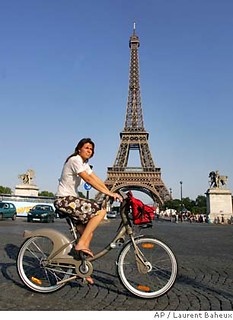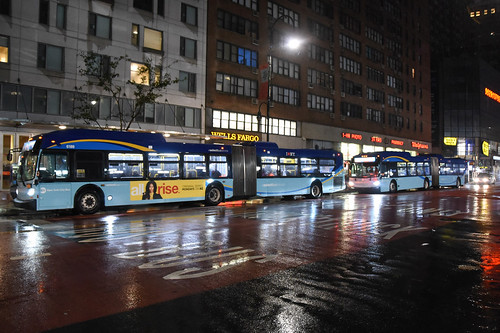New York's 14th Street, San Francisco's Market Street (and Toronto's King Street): When major cities adopt innovative practice it makes it easier for other cities to do something similar
Following up on last week's entry, "Speaking of "Just Do It": A 14th Street bus transit mall for Manhattan," on the introduction of a highly visible transit-prioritized street in New York City.
Many years ago, I heard Charles Landry, author of books such as The Creative City: A Toolkit for Urban Innovators and The Art of City Making, speak and I thought I heard him say something like "Great cities don't just take, they give" -- providing examples of best practice and innovation that other cities can learn from and adopt/adapt on their own.
 Paris and bike share. A particularly good example is Paris and bike share. They weren't the first city to do bike share, hardly. But they were the first to do bike share at a large scale, with an initial deployment of hundreds of stations and more than 20,000 bikes.
Paris and bike share. A particularly good example is Paris and bike share. They weren't the first city to do bike share, hardly. But they were the first to do bike share at a large scale, with an initial deployment of hundreds of stations and more than 20,000 bikes.It electrified not only cyclists but city leaders all over the world and it significantly increased the take up and deployment of bike share in cities all over the wrold.
It turns out he didn't exactly say that and Aaron Renn of Urbanophile credits me with making this point.
Toronto prioritizing transit on King Street. A more recent example is Toronto prioritizing King Street for streetcar service.
It came with a fair amount of controversy, and while streetcar throughput has improved significantly and ridership increased by X%, some businesses did lose patronage and sales -- although in that case, I argued it is because the city failed to develop a parking wayfinding and validation system to complement the changes.
Wikipedia photo.
From the Toronto Star article "Latest King St. pilot data shows higher ridership, shorter commutes":
New data released on the King St. pilot project shows overall ridership was up 11 per cent during May and June.Dedicated transitways aren't a new urban design treatment. Dedicated transitways aren't new--many cities had them in the 1970s and 1980s -- but as city centers declined as a loci for shopping and pedestrian movement, many cities dropped them.
According to the new numbers released Wednesday, ridership rose by 35 per cent during the morning commute and by 27 per cent during the afternoon rush hour.
Travel times have also been reduced by approximately 4 to 5 minutes, according to the city. This is in each direction during the afternoon commute for the slowest streetcar travel time. Average travel time during the midday also improved by 2 minutes.
The data also shows transit has become more reliable in the downtown core, with 85 per cent of streetcars arriving within four minutes during the morning commute. ...
The project has attracted controversy, especially from local business owners such as Al Carbone, owner of Kit Kat restaurant at King and John Sts., who called on Tory back in January to reverse it “immediately.” He said revenue for some establishments dropped by half.
However, according to the release, “Customer spending on King St. since the pilot began has seen a slight growth (0.3 per cent) from the average rate of spending over the same months from the year before.”
Even so, smaller cities like Portland, Denver, and Minneapolis not only introduced "transit malls" where bus service was prioritized (Portland later added light rail) and automobile traffic banned, but have continued to invest in and improve these spaces.
Still, the concept of more cities adopting dedicated transitways as a method of improving transit service -- the speed of vehicles -- in recognition that it's more important to focus on moving lots of people more quickly rather than facilitating the movement of a person or two in every car, and that high use bus and streetcar lines move significantly more people more efficiently has been pushed forward not by the great examples of Portland, Denver, and Minneapolis, but of King Street.
New York City's 14th Street. Pushed forward originally because the L subway line was scheduled to be closed for 18 months for repair and rehabilitation, New York City has moved forward with a "pilot" of its own -- making a central section of 14th Street in Manhattan a transit priority street, with most motor vehicle traffic being banned.
Despite all the clamor of all the likely negative effects, traffic on other streets didn't come to a standstill and bus movement has improved significantly ("Cars Were Banned on 14th Street. The Apocalypse Did Not Come" and "Riding the Bus on the New 14th Street," New York Times.

Seth Gottfried, New York Post
It helps that Manhattan has a robust grid-based street network, so there are many other options for drivers other than 14th Street.
And while the city was initially somewhat diffident about stating whether or not what happens on 14th Street would lead to the creation of other transitways elsewhere, now they are being more declarative about the concept. Not that the New York Post is happy about it ("14th Street is only the beginning for NYC car bans, top transit official says").
San Francisco votes to ban motor vehicles from Market Street. Like King Street, San Francisco's Market Street is a major and central thoroughfare and spine in the core, and a major route for both streetcars and buses. In fact, historically at one point it had four streetcar tracks, which is one of the only examples I've come across where streetcar traffic was so heavy.

(It wasn't unusually for a street to have more than two tracks when part of the street was used for another route, but usually this was for a short section, while the Market Street double trackage was for a significant distance.)
Yesterday, the transit agency board in San Francisco moved to make Market Street a transit prioritized street also ("SFMTA votes to restrict private vehicles from Market Street in bid to make area safer," San Francisco Chronicle).
The Better Market Street Project will make sustainable mobility (not just buses and streetcars but cyclists and pedestrians too) the priority on a two mile section of the street.
Incremental change. While I argue above that Toronto set the stage for New York and San Francisco, that may be overstating the case. SF and New York City have been recent leaders in creating dedicated lanes for surface transit, albeit in corridors that remain open to motor vehicle traffic.
Moving from mixed trnasitways to dedicated transitways can be seen as but an incremental step forward, but still a quantum jump in practice.
And Brooklyn's Fulton Street Mall has been a transit mall since the 1970s ("The Fulton Street Mall: Retail Success on NYC’s Original Transitway," Streetsblog). And outside of Manhattan, the transit and pedestrianized Fulton Street district has remained a successful retail center that draws crowds and higher than normal rents.

Before and after, Times Square. NYC DOT photo.
Other initiatives that transitways build on include "road diets," initiatives in New York City (which also triggered adoption of the practice elsewhere) to shift road space to pedestrian uses in Times Square and along Broadway in Manhattan (and then in other places around the city), creating and extending bikeway networks, and reducing the amount of space dedicated to parking, for parklets, bicycle sharing stations, dedicated bikeways (cycletracks), and other uses.
Long process. And all of these projects take a long time. Toronto first proposed the King Street initiative in 2007, but it was not until 2017 that they were able to do it. New York City has considered transit priority streets for quite awhile, and past initiatives did not move forward. San Francisco has been working on speeding up transit on Market Street for a long time also.
Each of these cities deserve a lot of credit for making key streets transit priority in the face of intense opposition from businesses, residents, the automobile lobby, and other stakeholders.
Other benefits. Canada's Atmosphere Fund argues that the benefits of transit priority streets are considerable and greater than mobility throughput, including:
1. Improved public health
2. Vibrancy & accessibility
3. Economic prosperity
Labels: busways/transitways, car culture and automobility, sustainable mobility platform, transit marketing, transportation demand management, transportation planning, urban design/placemaking




2 Comments:
https://ny.curbed.com/2019/10/18/20919729/new-york-transportation-bus-lane-transit-priority
Bus ridership up about 15-18% during the week, and up to 37% on weekends, on some routes using 14th St.
https://www.metro-magazine.com/bus/news/736036/new-york-s-select-bus-service-improvements-boost-ridership-by-37
Post a Comment
<< Home